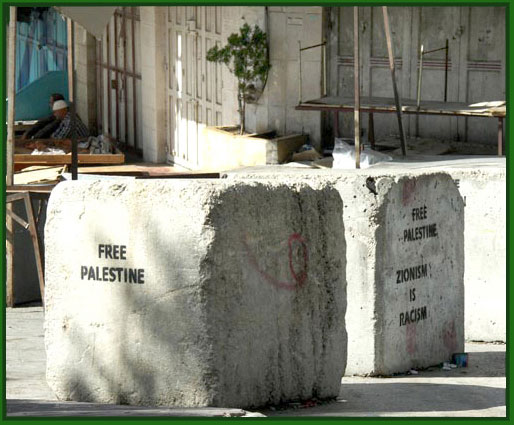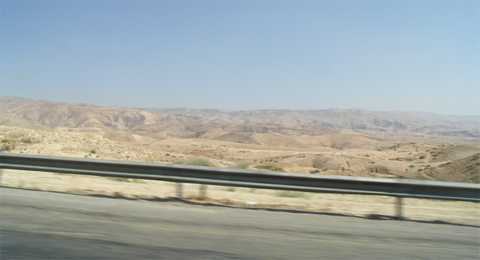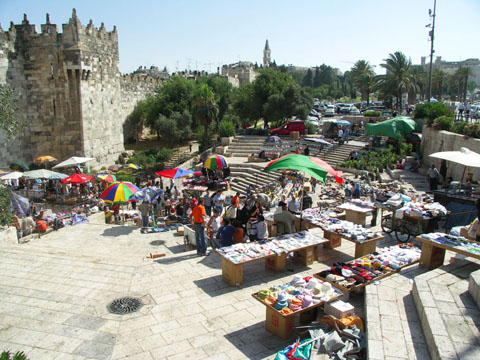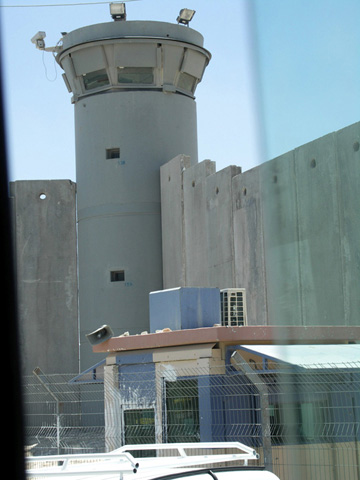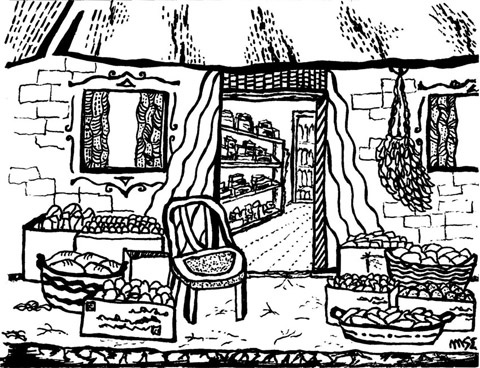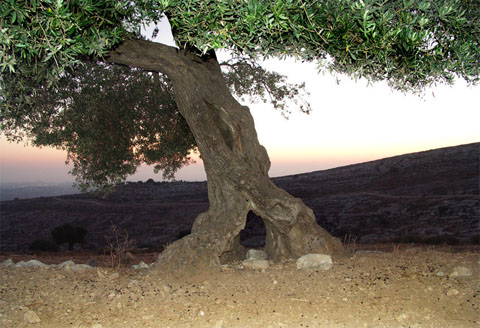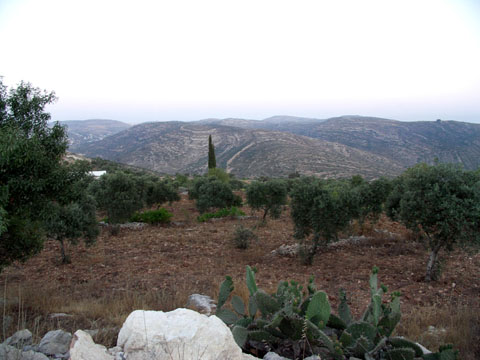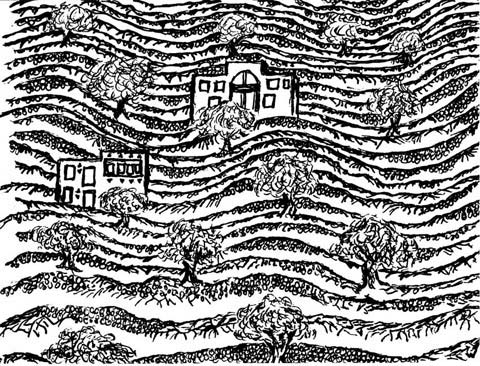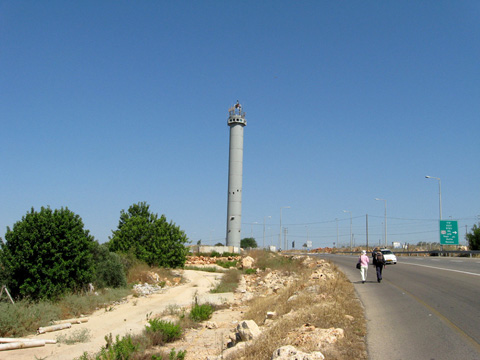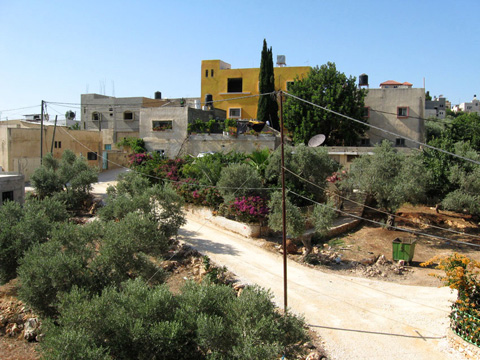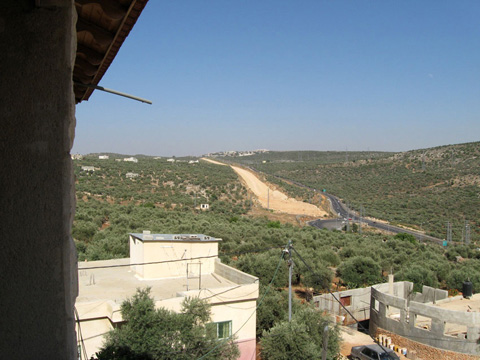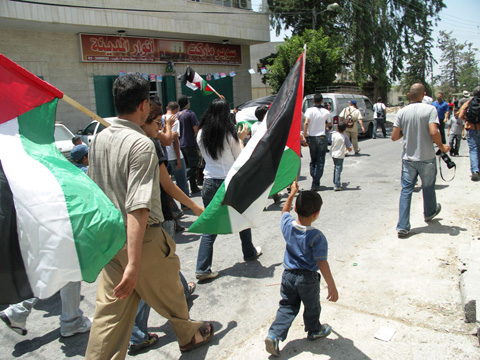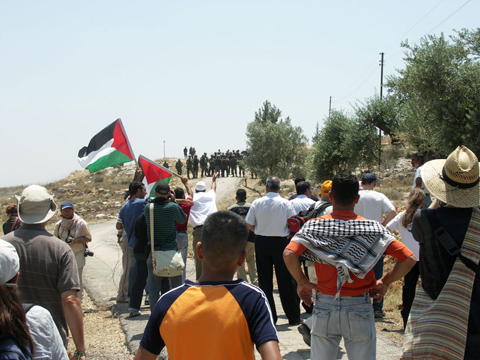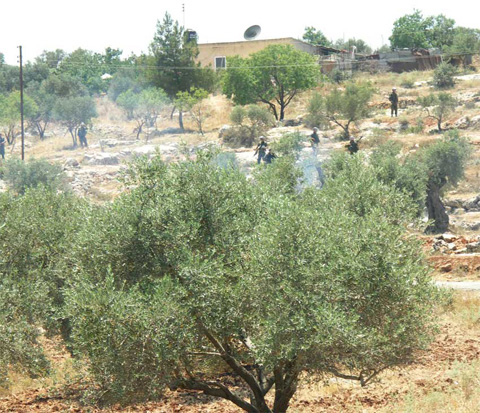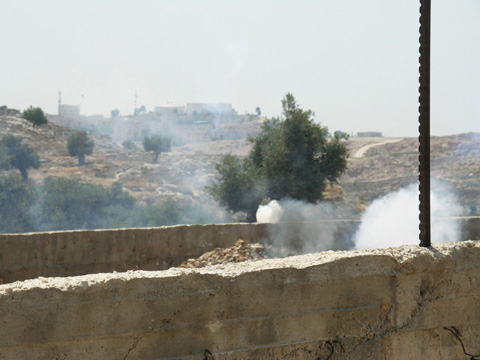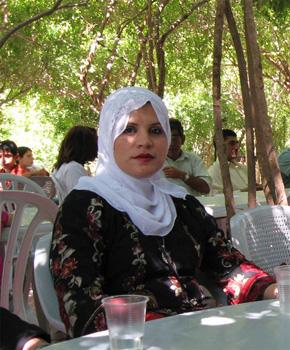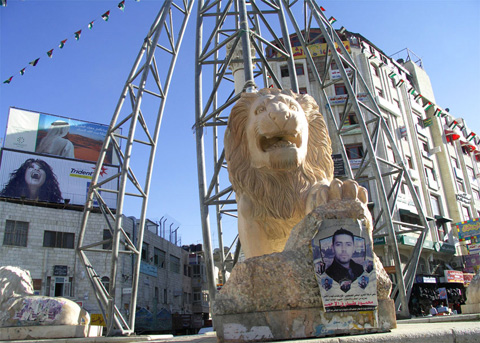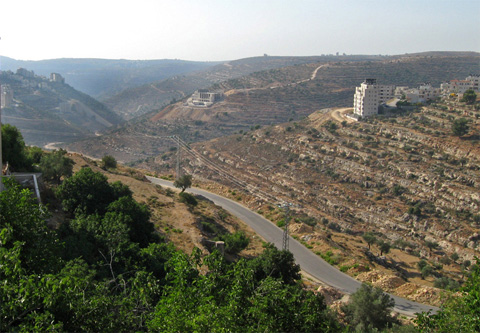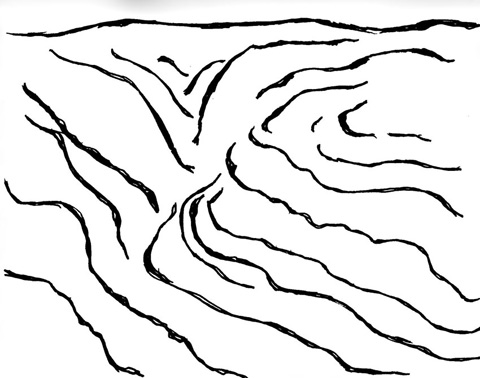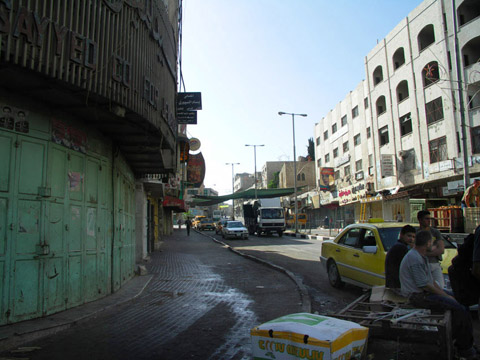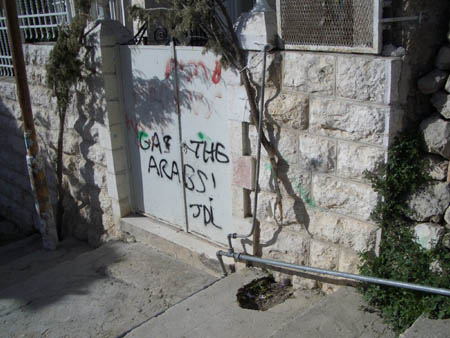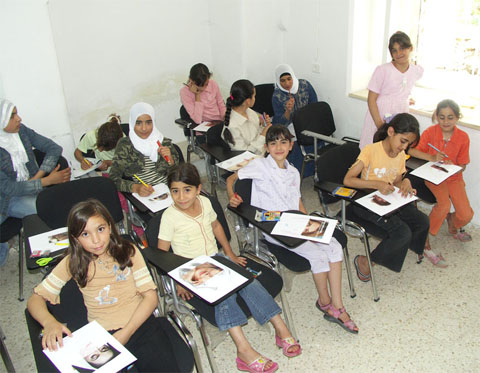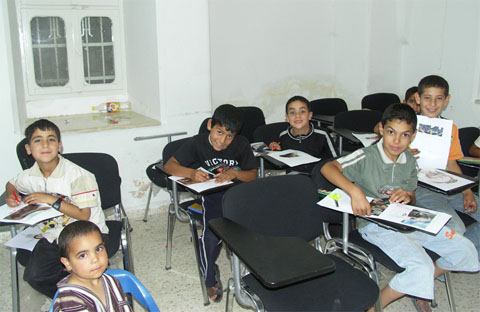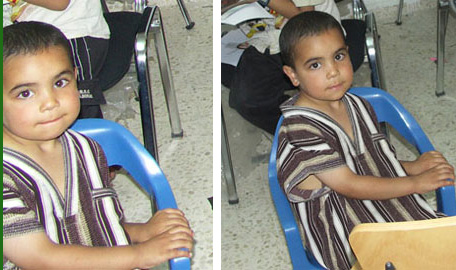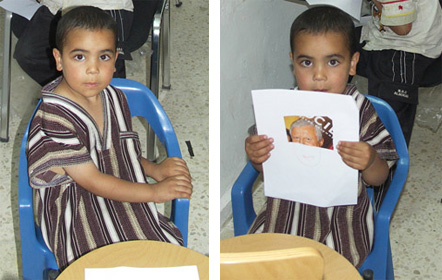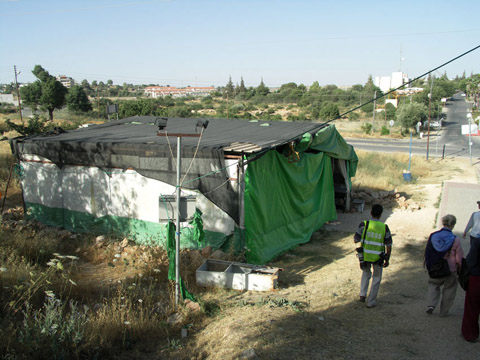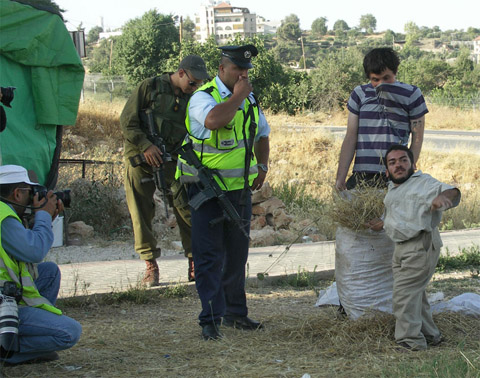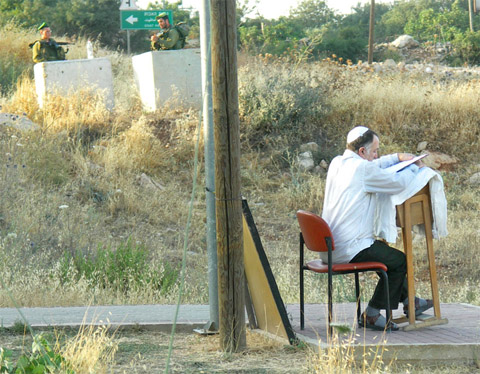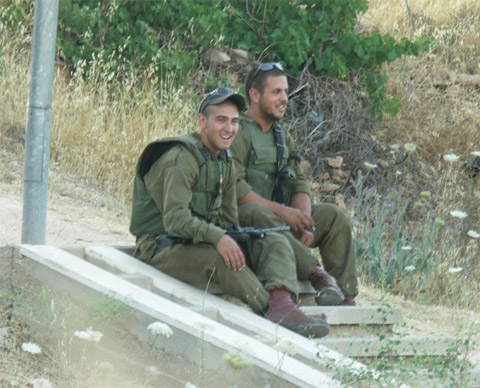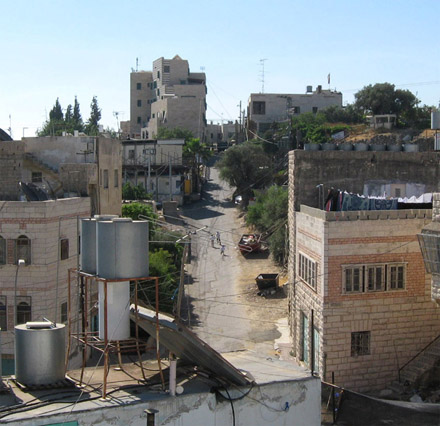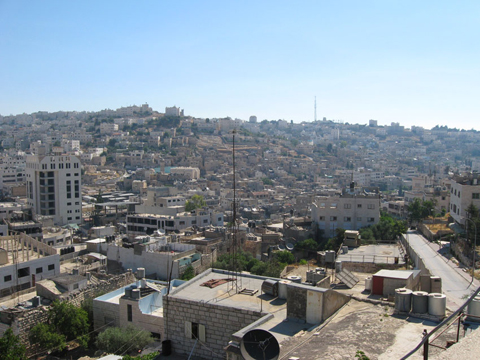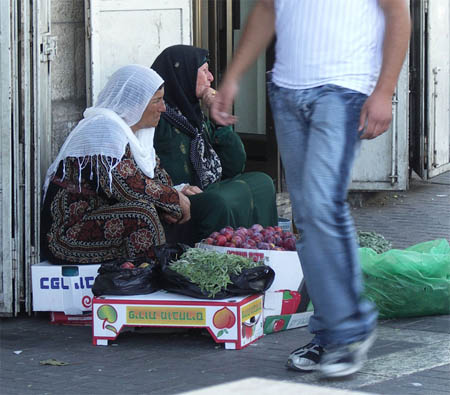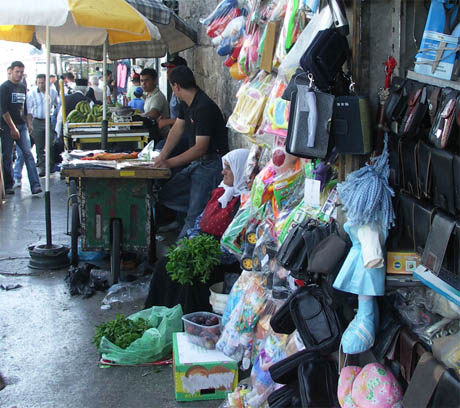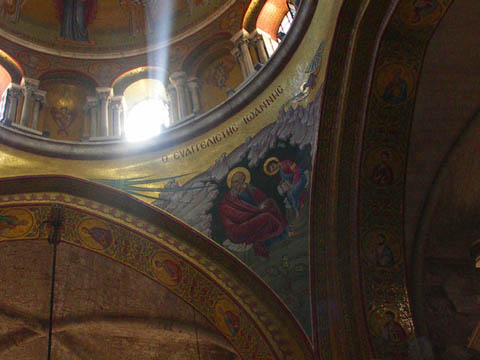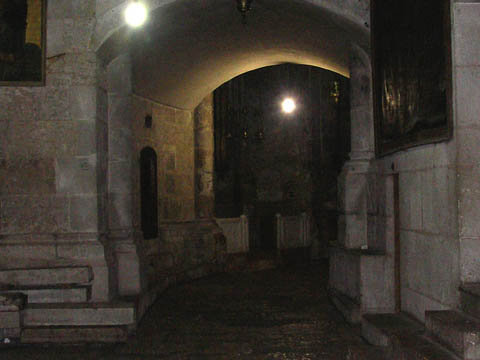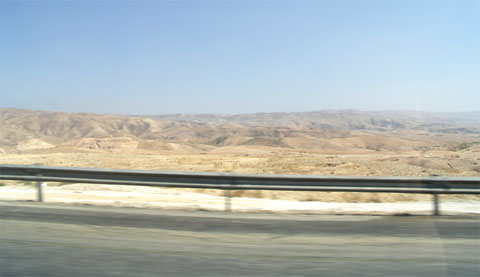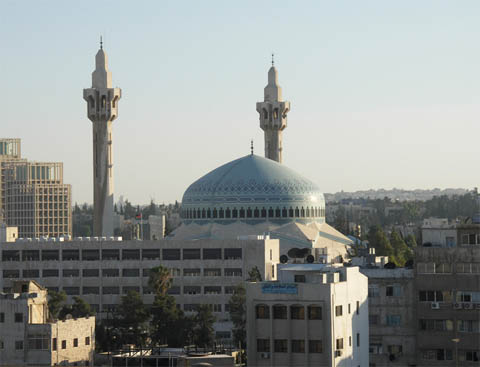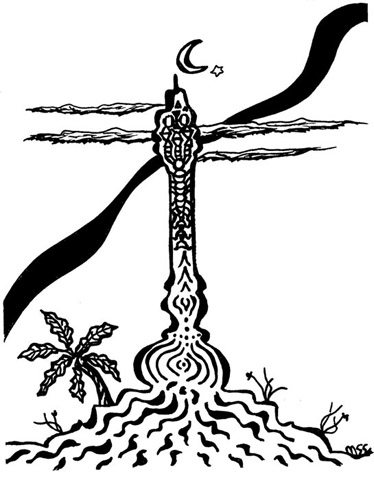I am eminently grateful that I was able to return to Palestine this summer! The trip was powerful, all-encompassing, amazing, grueling, heartrending, horrible and beautiful… all that I imagined it would be and more. This webpage full of stories and photographs is a way for me to share some of my experiences from the trip. The black and white drawings I did while traveling. To see larger versions of the photos or drawings, click on them. To navigate to the different stories, click on the content list or just keep scrolling down.
Flying into Amman and the Paid-Militia, Taxi Service
I flew to the Middle East via Amman, Jordan. My one anecdote relative to my arrival is that the first “sign of home” I witnessed upon disembarking at the gate was a thuggy-looking guy, well inside all of the security perimeters, passport, visa and customs checks, holding a sign that said “Blackwater”. He was there, obviously, to collect a new mercenary to add to the approximately 180,000 strong, privately-contracted force we’re paying for — in addition to, and at much higher rates — than the approximately 160,000 U.S. soldiers also in Iraq. Blackwater is one of the largest providers of private security assets to the U.S. military and is owned by Erik Prince, multimillionaire, right-wing Christian and ardent Bush supporter (which helps when getting all those massive no-bid contracts!). The person picking me up who was the brother-in-law of a man I met last time I traveled through Jordan, was waiting for me out by the sidewalk along with all of the other people picking up travelers — or at least those of us who weren’t arriving as hired guns.
Crossing the Border into Israel
In Amman, I met up with my friend and the next morning we proceeded down through the stunning Jordan Valley to the Allenby Bridge land-border crossing into Israel. This is the way that almost all Palestinians come and go from the state of Israel — at least those who are actually able to obtain visas allowing them to travel. It’s also the route used by Palestinians who live elsewhere and are coming to visit or do business. As such, it’s bedlam…. a checkpoint on super-steroids, a weekend walk in the park compared to the most crazed and time-consuming procedures at any U.S. or European airport….. massively understaffed with Israelis in their late teens and early 20’s bent on slowing and thwarting people’s passage at every step of the way.
The Jordan Valley
I had my fears about being let into the country, but was determined to be allowed entry…. with positive thinking and a good story. They did confiscate my passport upon seeing my name come up in their computers and told me to go sit down in the detained area. I’d love to see what dirt or insinuations actually come up on their screen — whether it’s something juicy or just a little frowny-face symbol… my friend and travel companion came along right after me and amazingly, after the hassle she had getting in two years ago, was given quick clearance. At this moment in time, internationals are having less trouble “visiting”, which is why I chose to go now. In great solidarity, she chose to come and sit with me in “detention”, even though it might have eroded her chances for entry had I been denied. They separated us from the others who were waiting, put us over by the gas-machine which blasts people with some probably toxic chemical supposedly meant to detect explosives’ residue where we then sat and laughed and told stories for 45 minutes or so until, with no fanfare, a twinkie solider kid came up and handed me my passport back and indicated we could go.
Bedouin camp
Jerusalem — the Souk and the Old City
We took a little bus/shared taxi through the West Bank to Jerusalem, witnessing along the way the evidence of Jerusalem being ever more surrounded by huge, illegal Israeli settlements — glistening, military-gated “communities” strategically placed on hilltops and water aquifers, beautifully constructed with U.S. tax dollars. Once in Jerusalem, or Al Quds as it’s called in Arabic, we stashed our luggage at the lovely and ancient Knight’s Palace Hotel, located in the Christian sector of the Old City and run by wonderfully warm and welcoming Palestinians. Then we set about dealing with the necessities of acquiring shekels and cell phones and still had time to spare to thoroughly wander the over 3000 year-old, Old City and the souks.
Damascus Gate
In the more touristy sections of the Christian, Muslim, Jewish and Armenian areas of the Old City, one daren’t even make eye contact with the goods displayed nor the shop owners lurking unless one wants to undergo a hard-sell that can reach near interrogation-level abuse. Please don't let my sarcasm in any way make light of the fact that Israel condones torture in it's prisons and currently holds at least 11,000 Palestinian prisoners, 450 of which are children and 125 of which are women. Many are currently held in “administrative detention” which means they have not been charged with any crime and they can be jailed for up to 6 months with their detention indefinitely renewable.
But, for the moment, back to being a tourist. With one’s hat pulled down low, dark sunglasses on and an art of barely moving one’s neck while scanning, it’s quite delightful to peruse the beautiful wares. The Muslim section inside the Damascus Gate is the exception to the rule. It’s a working market that caters to real people and sells actual goods. And the proprietors are normal and not on the offensive. Just outside the gate on some days is another bustle of business, with hundreds of shoes-for-sale laid out on display on the descending stairs along with some plants and then every other manner of stuff set up on planks of wood laid atop cardboard boxes or just placed in some semblance of order on the ground. With it's crush of people, ad hoc display methods, and the incredible density of every manner of goods all in a 3000-year old setting, it couldn't be more different than the sanitized and generic U.S. mall or big-box store!!
Shoe sales at Damscus Gate
The Miraculous Dematerialization of Qalandia Checkpoint — and all that ruckus with Fatah and Hamas
The next day we set off for an errand to Ramallah — picking up a bunch of the stunning embroidery that we sell for the women from the village of Deir Ibzi’a. We got in another little bus and climbed the narrow and hilly streets up out of Jerusalem, winding our way north. Between the two cities is the infamous checkpoint of Qalandia which has morphed into something resembling a cross between an industrial cattle-processing facility in California’s Central Valley and a prison detention facility and a toll-booth from Hell. When I was there in 2002, it was made up of long corrals made of concrete road barriers, sniper posts looking down on the road and a “desk” for the Israeli soldiers made of a giant pile of sandbags located under a shade-giving tarp. We can again thank U.S. taxpayers for its impressive development into something Orwell might have included in his famous novel.
A little bit of Qalandia checkpoint
On this day, our only encounter with Israeli control of the West Bank was a single, machine-gun wielding soldier coming aboard the bus to look over the riders’ identity cards. Next thing we knew, we were in Ramallah! A moment’s background and explanation is required.
At this same time, the battle for control of Gaza was taking place between Hamas and U.S. and Israeli-backed Fatah. The mainstream media was suddenly reporting that the U.S. and Israel were calling Fatah and Prime-minister Abbas, “our friends” (as opposed to their usual moniker of being labeled terrorists and absolutely no one with whom we can negotiate) and reporting as well the delivery of significant amounts of cash and arms to Fatah to “help” them overthrow the legally elected government officials of Hamas, or at least those who hadn't already been illegally imprisoned by Israel. Fatah also took it upon itself in the days following to dissolve the Unity Government, which was the coalition of elected Hamas and Fatah leadership and which had the near unanimous backing of the citizenship.
As for what went down in Gaza, the Western press reported that Hamas suddenly rose up and violently overthrew all other actors, primarily Fatah. Just because they felt like it….right? Reporting from the actual ground paints a picture of "mysteriously" funded militias appearing all over Gaza, running amok and creating havoc and provoking Hamas to take control of the increasingly untenable security situation. In addition, there has long been a battle between the Western-powers’ backed “security forces” in Gaza led by U.S. backed warlord, Mohammed Dahlan and the more home-grown, Palestine-Liberation-Struggle-supporting Hamas. Myself and the people I was there to work with, and more importantly, the majority of Palestinians recently polled, believe that neither Fatah's government in the West Bank, nor Hamas' government in the Gaza Strip is legitimate. But last year's election of Hamas came as a political message of resistance to Israeli occupation and sent a message of extreme dissatisfaction with Fatah's failure to end it or even to protest it adequately and the international community's failure to be of almost any help at all.
My dog in this fight is neither Hamas nor Fatah, but the vast and doggedly persistent, non-violent resistance movement, about which we hear as much reportage as we do the about beleaguered, progressive third party initiatives here in the U.S.
It could also be mentioned that the reason for Hamas’ 2006 election victory had as much to do with the citizenship’s utter distaste for Fatah's corruption and its continuous concessions to the West than for its love of Hamas. Although Hamas also gains backing because it does have a well-developed system of providing all sorts of aid to desperate people within the Occupied Territories. For your information, Israel, under the international law of the 4th Geneva Convention has the duty to provide food, medical care and facilitate relief assistance to the occupied people of Palestine, but they do not do so and never have. Thus the burden of all manner of infrastructure and social services, hospitals, garbage collection, education, and all the billion things that go into a functioning society is left to the occupied peoples themselves and mainly, to the international community, to provide. And ten minutes in the West Bank (or maybe 10 seconds in Gaza) would irrevocably demonstrate how much misery is wrought by this form of economic starvation and slow genocide.
Anyway, back to the disappearing checkpoint — despite the massively heightened trauma and violence being perpetrated mostly upon the Palestinian citizens of Gaza — at this same time the Palestinian citizens of the Fatah-controlled, central West Bank were receiving a big pat on the head for their cooperation with Western powers in the form of sudden (if short-lived) freedom of movement and commerce. Thus we and a lot of other folks sailed around for the next couple of days relatively unimpeded.
Visiting Our Friends in Deir Ibzi’a
In the small village of Deir Ibzi’a, located about five miles east of Ramallah, we have friends with whom six of us from the Bay Area formed an NGO (Non Governmental Organization) in 2002. Its purpose is to raise money for college scholarships for kids from the village as well as help with much needed income by selling some of the gorgeous embroidery created by many of the women of the village. See www.deiribzia.org for photos and such from our first trip — tons of photos of the post-siege, kid’s summer camp we participated in in 2002.
Store in Ein Arik, the small village next to Deir Ibzi'a
Our time visiting with Deeb and Suzanne (his wife) and Feraz, Sonia and Tarik (his kids) was wonderful. They took incredibly good care of us. It goes without saying that we were fed delicious food and drank lots of sweet, minted black tea, sweet Arabic cardamom coffee, and sweet maramyia tea (sage leaf tea). I’m posting a number of photos of Deir Ibzi’a because I had more leisure to take a lot of photos and because they really capture the unmistakable beauty of the land of Palestine. As well as the proximity of settlements built on land formerly belonging to Deir Ibzi'a for most of the past century.
2000-year old olive tree
Sunset view of Deir Ibzi'a from the roof
While there, we spent many hours talking with Deeb, playing with the kids, getting Arabic drills/lessons from the kids, meeting with the women who create the embroidery, meeting with the other seven members of the NGO, visiting the newly opened computer center they’ve created, walking through the village and visiting the site of the two thousand year-old, still fruit-bearing, olive trees.
Cacti, olive trees, lone cypress, terraced hills
An anecdote about sleeping… on the second night while we were still in Jerusalem, my friend woke me out of a pretty sound (and heavily ear-plug protected) sleep to tell me she’d just heard gunfire. My brain stumbled around trying to think of a way to assess the situation and came up with the probably lame but seemingly pithy at the time, response of, “is there return fire?” I mean, I was more than half asleep and even were I awake, I wouldn’t necessarily have had a brilliant strategic response in mind. She said, no — no return fire and we dissolved into laughter brought on by sleep deprivation and the general impossibility of the overall situation and fell back asleep.
Our first night in Deir Ibzi’a she woke me again out of a pretty good sleep to ask me what in the name of god noise was going on. It wasn’t gunfire this time — it was hordes and packs of wild dogs all barking like mad. Soon followed by a donkey. And then a duck.
The next night in Deir Ibzi’a we hadn’t fallen asleep yet, even though it was the middle of the night. (Sleep patterns became highly erratic over there….) As we lay there talking, up started the gunfire. Which really, really set the dogs off. And the donkey and the duck. It was somewhat unnerving — the sound of a single gun being fired at seemingly random intervals and from slightly different positions. We had a fleeting hope that they were shooting the insane barking dogs. Just kidding, although we did crack ourselves up thinking so. Deeb’s house is the last house next to the big settlement which stole a lot of Deir Ibzi’a’s land and the gunshots were coming from the direction of the settlement. We figured it was just a settler out for some pre-dawn excitement and only had a moment’s nervousness when it seemed the shooting had driven the dog pack right up against the wall outside of Deeb’s garden, which of course made us wonder where the rifle-wielding nut-job was and if he was planning on coming much closer. Eventually it all died down, but for the dogs, donkey and duck. Luckily Deeb lived a little ways away from the mosque, so that the 4 AM call to prayer wasn’t akin to a sudden symphony being played immediately outside one’s window. Every other place I stayed in Palestine, the mosque was about 3 or 4 buildings away. And everywhere there were always wild dogs, donkeys, more often than not, roosters, always the call to prayer and the duck was optional.
I don't at all mean to make light of the situation by telling you we laughed, but when you're running on a wee edge of disorientation and hysteria, it's sometimes all one can do. Were we in a smaller village or in someplace like Hebron and heard gunfire in the night and had been there more than a couple of days and had our contacts with locals all lined up, we would have responded by trying to assess what was going on with the gunfire.
The Village of Hares and the IWPS House
After Deir Ibzi’a we traveled further up north to the village of Hares in the farming region of Salfit. This area is largely separated from all points south in the West Bank by the vastest Israeli settlement of all — Ariel. In order to travel from Ramallah to Hares, one has to go far east and all the way around the intervening settlement.
The IWPS (International Women’s Peace Service) is an ad hoc group of internationally based women who have committed for the past five years to lend a presence to the village of Hares and the Salfit region. The mission is to non-violently intervene in and document ongoing human rights abuses as well as participate in the larger non-violent, direct action movement. The house itself is the upper floor of the residence of the family who originally requested the international presence.
I’ll include a few photos from the village of Hares and mention that we took a walk on a rutted back-road that may become the main road people will be required to to travel upon when the section of Apartheid Wall blocks all access to the highway, turning the highway into yet anther Israeli-only road. As we walked, we observed what we deemed to be pooper-sucker trucks removing sewage from the individual houses and then driving out along this rutted road and dumping the waste directly onto the land alongside the road.
Untreated sewage from multiple sources is a pressing problem in the West Bank, including tons of untreated waste from the many settlements as well as industrial wastes from the industrial zones Israel has also located on stolen West Bank lands. There is only one (out of eight) fully functional Palestinian wastewater treatment plant located at Al Bireh, near Ramallah. Israeli Occupation Forces shelling destroyed imported materials from Germany that were intended for a new wastewater treatment plant in the nearby village of Salfit, which project will now be delayed for some years. The entire Salfit region has long been plagued by the massive amounts of effluent discharged from the huge settlement blocks bordering the region on two sides.
And just a mile outside the village of Hares (on confiscated land) is Barqan, an Israeli industrial zone with 80 factories. These zones are established in the Occupied Territories partly in order to avoid the environmental regulation they would be subject to in Israel.
Sniper tower overlooking Hares
View from IWPS house roof
Another view from the roof of the IWPS house — the cut in the land of Hares is the impending path of the Apartheid Wall which will surround the giant Israeli settlement of Ariel and further serve to cut off Hares and other Palestinian areas to the north from Ramallah and the south.
A Word on Bathrooms and Water in General
As it is, most all bathroom facilities in Palestine take a bit of getting used to, some much more than others. No toilet paper can ever go into the toilet itself. And there’s often a sometimes grody little hose instead of there being any toilet paper at all. The extremely wimpy, by U.S. standards, toilet paper that exists goes in a wastebasket alongside the toilet. And one tries not to flush the toilet if at all possible. Add to the mix temperatures reaching 100 degrees indoors and frequently and suspiciously leaky fixtures and a breeding ground for mosquitoes and you’ve got a situation that’s a little challenging for our pampered, first-world selves.
On the other hand, you can’t exactly luxuriate in taking long showers even if you could stand the smell and dodge the mosquitoes, given that there’s not enough water to do so in the first place. One is always, always, always striving to conserve water. Some Palestinian areas are allowed a monthly allotment of water and when it’s gone, it’s gone. Everyplace in the Occupied Territories pays dearly for use of the resource, even though it’s being sucked and stolen from aquifers underneath the Occupied West Bank. All water resources in the Occupied Territories were confiscated by a Military Order of 1968 and declared Israeli state property. The water system, such as it is for Palestinians, is administered, controlled and exploited by Mekorot, a private contractor working for the state of Israel.
So the settlements have pools and green lawns and first-world comfort while many of the occupied peoples live in squalor which would be certainly somewhat mitigated with access to enough water. The water shortages also greatly hamper the efforts of Palestinian farmers who are forced to rely primarily on rainwater for irrigation (and it only rains in fall and winter, just like the Bay Area). Thus almost ALL produce (and other goods as well, for that matter) come from Israel because Israeli fruits and vegetables are well-fortified with abundant irrigation and thus cheaper to produce.
The Weekly Teargassing and Demonstration at Bil’in
For the past two and half years, the people from the Popular Committee from the village of Bil’in — supported to a greater or lesser degree by non-violent, direct-action loving internationals and Israeli activists and anarchists — have staged a weekly demo every single Friday. Sometimes the demos are small with fewer than one hundred people. Sometimes they’re much larger and accompanied by elaborately made props and the international press. The only absolute constant is the guarantee that there’s going to be loads and loads of tear gas fired, sound bombs fired, rubber-coated steel bullets fired, sometimes live fire fired and minor to major injuries and sometimes beatings and sometimes deaths.
The deaths, as well as the most significant injuries numbering in the hundreds, have all been of Palestinians. But last summer, the Israeli troops did manage to fire two of those rubber-coated steel bullets at point blank range at a young Israeli lawyer. Hit in the neck and skull, it was a near fatal injury and some significant brain damage resulted. If you want to see a not-particularly-gory, but shocking, post-op picture, click here. And in April 2007 they shot Mairead Maguire, Nobel Peace Prize laureate from Northern Ireland, with a rubber-coated steel bullet an hour after she delivered a message at a peace press conference. But when they shoot us white people, they far less often take aim at the head or at significant organs.
The march begins from the village of Bili'n
The day I went was sort of low-key typical. About 120 of us walked from the village out toward the strip of militarized fencing which represents the Apartheid Wall at this point. The village HAS gone to Israeli courts to protest the confiscation of some of the 60% of its land stolen for the building of the Wall and by nearby settlements. They have technically won back some of their land in Israeli courts, but typical of what constitutes justice in these parts, the court's judgment in their favor has been blatantly ignored and overridden by the military and the settlers. The International Court of Justice has also declared the Wall to be illegal. So every Friday, they are still out there non-violently protesting, getting shot, tear-gassed, beaten, arrested, etc.
On this Friday, the march approached the 'line of demarcation" — the volley of tear gas canisters began and a few hours and 100 tear gas canisters and a some rubber coated steel bullets and a load of sound bombs and a few, more or less, minor injuries and the arrest of one of the leaders of the non-violent resistance in the village (who is still being held weeks after the fact) and a shot-up car later, we called it a day. One of the women I’d gone with got tagged twice in the hip and leg with sound bombs which aren’t meant to be fired at people as projectiles. They’re just meant to damage your ear drums. The tear gas is very nasty but for the most part feels pretty survivable unless you take a direct lungful of it or have some sort of asthmatic condition. In general, one’s eyes sting like mad and they fiercely burn along with your nose and throat and you feel like you can’t breathe because to do so makes the burning worse. But you smush your trusty, cut onion under your nose and gush snot and tears and after a while you feel better until you catch the next good whiff.
The Meeting
Members of the Union of Palestinian Medical Relief are always present, ready to attend to the suffering and wounded, while often being targeted themselves. They carry little spray bottles of perfume and give you a squirt on your face rag and this also mitigates the effects of the gas.
The tear gas and sound bombs start up
I found this youtube video: http://www.youtube.com/watch?v=NAMbzGr7FMAwhich shows some snippets of the many-hours long demonstration. It does a pretty good job of showing some aspects of the scene including how very interactive are the soldiers and activists and an interesting technique that’s used a lot — a group of young women all fall to the ground in a pile, grabbing one another’s limbs to avoid arrest because it’s harder to extract and separate individuals when they’re all tangled together on the ground. Often times a large group of people will all pile on someone to prevent their arrest — hopefully the person at the bottom of the pile.
Let’s just say that I’m not anywhere near as much of an “action” photographer as is the well-seasoned journalist who shot this video! The videographer was right up under the noses of the military as they shot their weapons, shoved people around, arrested the village leader, etc. Maybe he had a zoom lens or maybe his zoom lens was a lot better than mine! Or maybe he actually was shoulder to shoulder with the military, along with the demonstrators.
Afterwards, we back again to Deir Ibzi’a overnight, instead of to Hares, because we were invited to a special shindig for the Austrian donor representatives who gave the money to equip the new computer center in the village. After the hot, filthy, dirty, dusty, tear-gas covered day, that night was the best shower of the entire trip.
The Deir Ibzi’a Dinner for the Austrian, Computer Center Donors
A brief mention of the most delicious meal! Although the afternoon dinner did take place on the hottest day out of all of the days I was over there! Even for that area of the world, it was record-breaking heat….. probably around 100 degrees unless one were in the direct sun and then it would be much hotter. Not a single breeze. Extreme humidity. But the dinner was in a very pretty spot, outside under a lot of feathery trees. And at least we didn’t have on six pounds of total-coverage clothing as did some of the wives of the men in the NGO.
After sitting around trying not to move an extra muscle, we were served plates heaped with an absolute mountain of lamb and rice. Thankfully we were more or less starving by that point. It’s a traditional dish — the entire lamb is placed in a pit in the ground and it's filled with the seasoned rice mixture while it cooks. I got a leg!!!! It was massive beyond belief. We also got yogurt and 'condiments' of fresh cucumber mixed with yogurt and chopped tomatoes and more cucumbers and mint and other choppy veggies. All extremely delicious, though maybe not exactly precisely the meal to eat in that heat.... then sweet spiced Arabic coffee afterwards.
I did warm to the idea of drinking cup after cup of hot liquid (sweetened Lipton tea infused with mint leaves or sage leaves and similarly sweet Arabic-cardamom coffee) all day and all night long even though the temperatures are incredibly hot and humid. I don’t have a scientific sense of it, but I’m pretty sure that the steady intake of hot liquids actually cools one down because it causes one to perspire (even more than one is already….) and sweating is the body’s cooling mechanism. In theory anyway.
Suzanne at the dinner
More Mercenaries and Hired Guns
A few days later I found myself back in Ramallah staying with a friend and helping with non-violent direct-action trainings being given for a group of internationals from Sweden (heavily represented), England, the U.S. and Japan. Another friend had been targeted going through a checkpoint, arrested and summarily deported and as such, help was needed with the trainings he was working on. I’d never given this sort of training in Palestine, but I’ve given a lot of them in the Bay Area. I won’t say much about them, given that my participation in this activity has complicated my life in the past! As it and other affiliations with the non-violent resistance movement complicated my friend’s who got deported. Anyway….
There was one utterly bizarre element to the trainings and it was the presence of an infamous crew of gunslingers at the hotel where the trainings were held. Back to the Gaza/Fatah/Hamas storyline — there is a major heavy (mentioned previously) named Mohammed Dahlan who is, at present, the head of all security services in Palestine. Other things he is, and/or is considered to be, are: the leader of Fatah in Gaza, massively corrupt, extremely wealthy (i.e.: well paid), brutally ruthless, the orchestrator of the recent U.S. and Israeli-backed plan (as planned by Elliot Abrams, senior member of the U.S. National Security Council, and laid out for implementation by U.S. General Keith Dayton) to overthrow Hamas from it’s elected government position, and (long accused of being) an agent for the U.S. and Israel. The U.S. recently suggested he might make a good next president of Palestine, sort of like a young Saddam Hussein, maybe. Our kind of guy!
***Actually, an update. Dahlan recently resigned on July 27, 2007. The Western press says it's because he felt bad about "losing" Gaza to Hamas. But in a "possible" coincidence, on the day prior to his resignation, the Palestinian press published a letter written by him dated July 13, 2003 addressed to the previous Israeli defense minister, Shaul Mofaz, wherein he (Dahlan) is promising to brew division within Fatah ranks, destroy Palestinian institutions and replace them with a quisling leadership subservient to Israel. The official statements also had him resigning "for health reasons" although it may have been more for preventative health reasons, given all the dirt on him that has recently been revealed.***
But back to the storyline. After Hamas took over Gaza during the first week I was in Palestine, Dahlan’s slick, scary crew of cowboys decamped from Gaza and took up residence in the same hotel where the incoming international trainees are initially stashed and where some of the trainings for non-violent activism take place! It was a brilliant contrast to see all of the signature-scrutty (politely put, hippies, hipsters and anarchists) internationals alongside the too-cool-for-school, major hip-holstered guns at lunch, hashish and lotsa alcohol for dinner, expensive-looking-casual, dudes of Dahlan.
The latter looked as if they’d taken a wrong turn on the way to the Club Med for Arabic Mafiosos. Most of the internationals were clueless as to who these cats were and blessedly, an earlier group of internationals had wisely declined offers to party down with the non-Muslim-in-the-extreme-acting gangsters as they openly smoked hashish and drank alcohol in the hotel.
While I was there, we got to share the dining room with them for both breakfast and lunch…. our tables made up mainly of happily mellow young Swedes and members of the Palestinian non-violent resistance community and a smattering of other young, individualistic souls and theirs made up of muscled thugs leaned back in their chairs with their legs akimbo, cutting their eyes at everything that moved. Especially, but not exclusively, the cute, young Swedish women.
Sorry. No photos of the dudes! Their posing wasn't for the record.
The Magical Mercantile Bubble of Ramallah — The Politics
I wanted to describe a few things about the city of Ramallah. I stayed there for a few days with a friend and spent other days there doing errands and/or passing through. Ramallah is the de facto capital of the Palestinian territories. Palestinians want Jerusalem as their capital. Previously, Nablus was the de facto capitol and the economic and industrial engine of the Occupied Territories. For reasons too lengthy to explain, Nablus has been starved shut in this regard and everyone with money and business interests has fled to Ramallah. This flight has included business-people from Jenin, Hebron and other outlying areas. Ramallah is now the financial and mercantile capital and the Occupation is less keenly felt here than it is in most of the rest of the West Bank and Gaza. Though all is far from rosy — the Occupation is insidiously present and, for example, the Israeli army still feels free to come in and snatch or assassinate people at will. Though this is done far, far, far less often than it is in Gaza or in cities such as Nablus or Jenin. And the Israeli military isn’t a constant presence within the city as it is, for example, in Hebron.
When I was here in 2002, Ramallah (and every one of the major cities in the West Bank, except for Jericho) was under total lockdown — no one allowed on the streets lest they be shot on sight. We saw countless homes and buildings that had suffered shelling by tanks, cars which had been crushed by tanks littering the roadsides and tanks roaming the streets. We were stopped and questioned by a line of tanks as 20 of us internationals broke the curfew by walking 5 hours (with all of our luggage in tow) from Ramallah to Deir Ibzi’a. With our passports and our skin color, we could do that sort of thing. It was like a parade the entire way as Palestinians waved out their doors and windows and told us they wished they could leave their homes.
We were next door as tanks shot missiles at cars belonging to hospital workers which were parked in the hospital parking lot. Most of the hospital workers hadn’t “left work” for weeks or months at a time because of the ongoing, extensive “curfew”. The word curfew is deceptive. To our ears it sounds like an imperative given to a teenager to “be home by 11PM”, as opposed to a complete restriction on all movement imposed upon an entire population, including those suffering medical emergencies or desperately needing food, as is the case in prolonged curfews such as this one. Lesser versions of these lockdowns are still imposed by the Israeli military in other areas of the West Bank.
That said — Ramallah this time around was very different. As mentioned earlier, as a Fatah stronghold it was receiving extra bonuses for its “good behavior” and compliance with the demands of the U.S. and Israel. The tactic of divide and conquer seems to be being put into fuller effect. Some Palestinians are being given a measure of security and financial opportunity as a way to crush solidarity with those in the rest of the country who see nothing but a steady diet of woes and losses — continuous confiscation of their land and resources for ongoing settlement expansion and the building of the Wall, imprisonment with no access to due process for thousands, extrajudiciary killings, murder of civilians, including children, as “collateral damage” and collective punishment….. I hate to say it, but it’s almost too easy on some levels to forget or ignore some of these horrific aspects of Occupation because they are so damn commonplace and have been going on uninterruptedly and with almost no effective censure from the outside world for decades now!!! As sick as it is to witness it anew, I am incredibly grateful I was able to be viscerally reminded once again.
The Magical Mercantile Bubble of Ramallah — The Kaleidoscopic Beauty
I also want to say — all of the politics aside for a moment — Ramallah is an amazing city! Perhaps it’s what Palestine could be without the Occupation, ethnic cleansing and brutal land theft. It’s a city of fabulous hubbub. Streets branch out like spokes on a wheel from the Menara Circle in the center of the city. Goods absolutely spill out of small stores onto the sidewalks. Carts full of fruits and vegetables fill one of the spoke streets and other streets seem devoted to other lines of commerce (the clothing street, the kebab street...) Small children (with an edge of desperation) working as vendors sell gum, kites, carry little trays full of fresh juices for sale. People (ok, men) sit at small tables tucked tight amidst the goods and wares drinking their tea and coffee and smoking cigarettes. Men dressed in red satin suits with yellow braid and red fezzes dispense Arabic coffee from large, elaborate silver coffee urns bedecked with fake flowers and strapped to their bodies.
Beautifully embroidered dresses, cheap shoes and clothes, electronics and cell phones, internet cafes, nicer restaurants and tiny falafel and kabob places, freshly baked bread, hotels, jewelry, fabric, scarves, glassware, and live baby chicks which when sold are placed inside one of the ubiquitous, flimsy, plastic fruit cartons and then inside one of the ubiquitous, cheap, black plastic bags to be carried off to become chickens all compete with the streets and sidewalks teeming with people, busses, taxis, and old wooden carts full of goods. There are no traffic rules and as a pedestrian, one quickly gets used to the inch or less of clearance with moving vehicles because the sidewalks are too full of people and goods and one has to walk in the street with the cars, taxis, busses and carts to get anywhere. The car horn is the major navigational tool if one is in a vehicle.
The Menara
On one hand it could be said that business is thriving, with the reminder that it’s in contrast to the poor and devastated villages no longer able to farm, the atrociously poor slums and ghettos of the refugee camps throughout the country and the other cities which are under constant threat of invasion and closure. But Ramallah, even in all its glory, is a vast world of difference away from our first world version of wealth and commerce and infrastructure — or, indeed, from Israel’s clean and prosperous and eminently grand and on an absolute first-world-scale, cities. Even in thriving Ramallah, there is a clear and obvious level of poverty which would remind us much more of a poor city in Mexico than of Tel Aviv or San Francisco.
I stayed for a bit at a friend’s apartment located a short distance from the Menara. During the short taxi ride to her place, we came up upon a rattly little pickup truck emitting a monstrous fulmination of white gasses. With some horror (and while trying to hold my breath), I asked about it and was told, “It’s for the mosquitoes”. Ah. DDT. As we got closer, I could see four guys sitting perched in the back of the small truck, directing the gas or just going along for the ride, and completely enveloped in the fumes. I have to admit, there were a lot fewer mosquitoes when I slept there at night… My friend lived in the last building at the edge of a gorgeous wadi — a valley or a dry riverbed — with sweeping views of the steeply sloped hillsides progressively winding into the distance. Palestine is a radically beautiful and dramatic land, geographically speaking.
Geopolitically, it’s the vast majority of the population’s sheer will to live in daily, non-violent resistance by virtue of holding on to whatever they are able in the face of ridiculously stacked, ever-mounting odds that maintains anything resembling viability for most of them. To be there is to witness the fact that it is the spirit of the people that IS the resistance. This quality is called “sumud” — remaining steadfast.
Hebron —Art Classes Amidst Especially Ugly Occupation
Hebron on Friday, Holy Day, with the stores closed
I next traveled to the southern part of the Occupied Territories to the large city of Hebron. My friend, who is herself a phenomenally gifted artist, has been offering ongoing art classes for children who live under especially wicked circumstances. They live in H2, the Israeli-controlled area of Hebron where 4000 Israeli soldiers “protect” 500 settlers who live amidst 35,000 Palestinians. The permanent military occupation of H2 is not subtle. There are armed Israeli soldiers everywhere, patrolling, manning checkpoints, looking down from rooftops and guard towers and actively harassing the Palestinian population. The rights of the Palestinians in Hebron are totally sacrificed for the perceived security of the Jewish settlers living there. Palestinians are not even allowed to drive cars.
The settlers in Hebron have a well-deserved reputation as being the most violent and virulent in terms of their hatred of Palestinians. And unlike the many other settlements, they live immediately amidst the Palestinians. They are allowed to carry guns openly. They are allowed to drive their cars. They are allowed to raid people’s homes, spit at people, throw stones at them, and beat them. They are allowed to steal and confiscate people’s homes and stores after they raid them, driving the inhabitants out. They are allowed to spray paint Jewish Stars of David on the walls and doors of Palestinian homes with the epitaphs, “Kill All the Arabs!” and “Gas the Arabs!” Charming. And the Israeli army is there to protect them as they do so. And we were spit upon and cursed and had stones thrown at us as we walked with Palestinian friends past a long row of settlers returning from attending their religious prayers and services at the Ibrahim Mosque.
Yes, coming from the mosque. Even the mosque has been partially confiscated. It is divided, one side for Jews and one side for Muslims. It has been that way since 1994, when a Jewish doctor from New York by the name of Baruch Goldstein entered during Morning Prayer and opened fire, killing 29 worshipping Muslims and wounding 125. This is the storyline repeated over and over — the settlers behave atrociously and are protected and rewarded. There is so much more that could be said to describe the active Apartheid of Hebron, but for this part of the story, I’ll just say that it is particularly brutal on the lives of children who are regularly attacked by adult settlers and soldiers alike, require accompaniment to travel safely to and from school and do not play outside their homes for fear of attack. In the midst of this, my friend offers her beautiful art classes.
She warned me that the children would initially run into the room looking a little wild, but assured me that they’d rapidly sit down and be ready to work. This was more than true! Soon after finding their somewhat make-shift seats and tables, both the girls’ class and the boys’ class in turn were ready to listen and attentive to directions as to their art-project of the day. My friend has put so much love and consistency into these classes and it more than shows in the level of trust and focus present in the children!
She’s also put out a call for more teachers to come and volunteer. In fact, arriving with us that day was another wonderful woman from the U.S. who had come to teach English and yoga to the kids! The kids especially loved the yoga!
This little guy was amazingly dear. He's 4-years old.
Land Theft and Hand-Picking Grass for Goats
Another aspect of participating in non-violent resistance is going out on “actions”. An action can be described an intentional assertion of human rights and dignity where those things are often actively denied or repressed.
On this occasion, 20 international human rights workers and some Palestinian members of the press accompanied the children of a very large family out to the fields adjacent to their home. By “very large family”, I mean a mother and father, their six married children and the many children of those six marriages, including a number of physically disabled children and adults. Only one of the adults came along because if the others had come, they would be subject to illegal harassment and arrest as has happened in the past. The lone adult sibling who did come along was a man of incredible calm strength and courage, but because of his disability, he lives in a crippled, child-sized body.
The family’s home and small parcel of land lies between two settlement blocks which are closing upon it like a vise. The plan is for the settlement blocks to eventually squeeze out all of the Palestinian homes in the village that lie between the two settlements. Settlers have constructed a broad, paved, stair-stepped pathway across the family’s land in order to connect the two settlements and armed settler guards are always posted on the land. Even more obscenely, the settlers have erected a tent upon the land and have deemed it a “synagogue” — it is “holy” and thus given even more protection from the military and settlers. For the past many years, the family has not had access to this land upon which they formerly grazed their goats and grew figs and grapes. They’ve even gone to Israeli courts and won a court order allowing them access to their land, but armed settlers and the Israeli army effectively override that judgment of the court. The family members have been shot at, beaten and imprisoned for daring to set foot upon their land.
The supposed synagogue with the settlement across the street.
So on this afternoon, our action was to go out there and begin to hand-till one chunk of the field. It was the chunk directly adjacent to the raggedy synagogue tent. With the internationals ranging in age between 20 and 70 and coming from a host of countries and all of the children and the one dad we filled scores of bags with the thorny, dried grasses all pulled by hand from the ground. I was very happy to have with me a pair of hot pink rubber gloves I’d bought earlier in the trip in order to help clean the places I found myself staying. The gloves helped immensely when it came to keeping the thorns out of my hands and as such, now over a month later, I still have one lodged in my thumb! But everyone else worked bare-handed and uncomplaining. We also cleared around the choked grapevines, pruning them as well. And as is the custom, were all served sweet minted tea in little glasses when it was time to take a break.
We didn’t work alone, though! As we cleared the field, an ever-growing assemblage of Israeli military and military police and their many vehicles showed up and lined the road alongside the field. The soldiers surrounded the “synagogue” and positioned themselves with their guns and the varying military and military police honchos came up and positioned themselves and gave a few orders and questioned the one adult family member. I loved the way that this man, crippled in body but huge in spirit, stood steadfastly at their knees, placing himself as a barrier between the military and all of his children and us, his back to them, defiant. He had the court order with him and they examined it. On this day, probably because there were so very many internationals as well as a few members of the press, we weren’t particularly hassled beyond the ridiculous show of force.
The press, a soldier, the military police, an international and the man from the family who owns the land.
We weren’t ordered to leave until we were actually just about finished with our task. I should also mention that a settler did make his presence felt by bringing the Torah out of the tent and setting up his praying/rocking bench and proceeded to spout his prayers to (I guess) the four directions (that he intends to own all of?) while his angel-protectors with their machine guns provided a back-drop (and back-up against a bunch of grass-picking people?)
As a finale to our process, the goats belonging to the family were brought down to the land. The goats, like the family, aren’t allowed on their land so it must have been a treat for them to come and munch the forbidden grasses. And the most amusing aspect of adding 20 to 30 goats to the convocation of international activists, Palestinians, and Israeli military is the way in which everyone’s point of focus became the goats! Children and soldiers alike watched with grins as the floppy-eared, funny-faced creatures unselfconsciously took over the scene. Even the military commanders were seen suppressing smiles but allowing some interest.
These guys maybe thought the goats were cute
Afterwards, back at the family’s house we were all served more tea and coffee and cookies and a few people got to ride on the family’s Arabian horse! If there continues to be enough of an international presence, the plan is to continue going back out to the field and further prepare it for agricultural use once again. But with the way things go, in the end it'll probably end up being stolen by the settlers.
It was beginning to get dark, so we began our walk back to the Tel Rumeida area of Hebron. More adventure ensued. Along the way, we passed hordes of settlers on their way back to their settlement after attending services at the mosque. As mentioned earlier, the Israelis gained use of half of the mosque in 1995 after a settler murdered 29 Muslims at prayer and wounded 125 others. Our group at this time numbered about nine internationals and two Palestinians and we were walking into the oncoming swarm made up of scores of settlers, all dressed somehow ominously in white. The energy directed at us bristled with hostility until finally the slurs and insults started up, followed by spit and stones. Shortly after getting past the worst of the things being hurled at us, we came upon Israeli soldiers and told them that we had been attacked. And they responded by detaining the one young (26 year old) Palestinian man with us, taking his ID and searching his belongings and questioning him as we gathered around and questioned the soldier and his inappropriate actions.
Meanwhile, under cover of the darkness, another soldier grabbed the Palestinian boy who was with us (15 years old) and quickly threw him up against a wall and began punching him in the stomach, grinding him into the wall and kicking his legs out from under him. All of this happened really fast and as soon as we noticed, we all began yelling and the soldier resumed frisking the boy and then let him go. Earlier I’d wondered why this boy was a chain smoker at such a young age. Not that smoking actually relieves any of the stress of being a designated target and punching bag, but then not much else beyond the occasional presence of a few internationals interceding on his behalf is likely to relieve the stress either.
Our last encounter of that evening came when we had to pass through the trailer which blocks the street and serves as a checkpoint at the foot of the street we were staying on. Two young soldiers demanded our passports. We were only internationals at that point as the man and boy had gone home. As his method of looking at the info inside our passports, the kid stuck the barrel of his M-16 directly into each of our chests so as to use the cute little flashlight attached to the barrel of the gun. We’d hold out our passport, he’d stick the gun in our chest and the flashlight would shine on the passport (which, chances are, he probably couldn’t even read.)
As done to us internationals, it just a freaky prank rather than any sort of a threat. But the power dynamic of such a stunt has vastly different meaning when done to a Palestinian child or woman or grandparent or man. An eighteen year old soldier with his M-16 holds total power over the population of the Occupied. And if that power is challenged, he can beat them, arrest them or kill them with impunity.
For the record, it’s hard to have a gun stuck in your chest. Even knowing there’s absolutely zero chance of the thing going off, it brings up feelings. This sort of shit directed at our group of untouchable, white people still caused varying strains of frustration, sarcasm and antagonism to arise. And one young woman broke down in tears afterwards, not so much at the singular event so much as at it’s being yet another in a long, long series of such crap directed at herself and the people she’d come here to stand with in non-violent solidarity. And it bears mentioning that we internationals almost always have a far weaker threshold for enduring abuse than do the Palestinians. They have sixty years practice at maintaining a certain dignity while facing repeated pain and humiliation. We sputter and boil a lot quicker and often it’s the reminder that if we cause a ruckus, it won’t be taken out on us but on our friends instead, that causes us to button our lips as well.
Settler children running down the street past Palestinian homes which have been forcibly taken over by settlers (seen from the roof of our house).
I was so glad to have been able to visit Hebron on this trip after always having heard so much about it. I stayed in a neighborhood full of homes and storefronts from which the Palestinians have been driven out. Some have been actively taken over by settler families and are bedecked with Israeli flags. All Palestinians coming and going (on foot of course, since they aren't allowed cars) are stopped on the corner below and must turn over their bags and belongings for inspection. Children have to turn over their schoolbags. Men have to lift their shirts.
A short distance later, they must pass through the trailer/checkpoint I mentioned earlier where the soldier kid got creative with the flashlight on his M-16. When possible, there is an international presence in this neighborhood of Tel Rumeida, as well as in the whole H2 part of Hebron, because the extreme harrassment and humiliation from both Israeli military and settlers is a daily reality. Children especially need help getting to and from school.
Yet even with this level of awfulness, I promise to anyone if they were to go there, they would love it simply because of the people. Maybe all this awfulness manages to bring into clearer relief the aspects of human connection that are precious. There is a kind of community and intimacy that is dearly missed after coming home to our well protected and highly individualized lives in the United States.
Looking out over Hebron - looking a different direction from the roof
Another view of Hebron from the roof
Parting Shot of East Jerusalem (or Al Quds as it's called in Arabic)
I want to show a few photos of the bustling street market scenes in Palestinian East Jerusalem taken the day before I left.
Women selling sage (called maramia in Arabic) and plums
Woman selling mint (called nana in Arabic)
Visit to the Church of the Holy Sepulchre
Before catching my taxi to the cross the border back into Amman via the Allenby Bridge, I visited the ancient Church of the Holy Sepulchre in the Old City of Jerusalem, originally built in 335 AD and then destroyed and rebuilt a few more times.
From Wikipedia: The ground on which the church stands is venerated by most Christians as Golgotha, the Hill of Calvary, where the New Testament says that Jesus was crucified. It is said to also contain the place where Jesus was buried (the sepulchre). The church has been an important pilgrimage destination since the 4th century.
And from another interesting site with a lot of historical information: The church's chaotic history is evident in what visitors see today. Byzantine, medieval, Crusader, and modern elements mix in an odd mish-mash of styles, and each governing Christian community has decorated its shrines in its own distinctive way.
But it is a beautiful and evocative place!
The Stone of Unction where it is said that Jesus' body was annointed and prepared for burial. Most of the people kneel and kiss it, so hopefully it has sacred germ-deterring powers.
Looking up at the cupola of the Catholicon
Exterior facade of the church
Cool, spooky archway
Leaving Palestine, Flying Home
The trip out wasn’t too eventful — driving back took me again past the huge settlement developments, aware that the next time I pass this way there will be scores more. In May 2007, on the same day that the World Bank (hardly a left-leaning organization) issued a report stating that Palestinians in East Jerusalem have extreme difficulty obtaining building permits from Israeli authorities and that a disproportionate number of demolitions of Palestinian homes occurred in East Jerusalem, Israel announced plans to build 20,000 new settler units on the outskirts of occupied East Jerusalem. These units will house almost 100,000 additional new settlers.
The announcement to expand upon the already substantial settlement block came a day after Israel demolished a home and center for disabled and special needs children in the East Jerusalem neighborhood of Wadi Joz. Israeli border police forcibly evicted the caregivers and children at dawn, according to the Israeli Committee Against House Demolitions. The reason given for the eviction and demolition was that the center lacked the proper permit. Building permits are often impossible to obtain and all building within the Occupied Territories must be issued a permit by Israel.
And the big checkpoint outside of the Allenby Bridge crossing wasn’t terrible. It had been much worse earlier in the day with a 70 vehicle back-up. My taxi driver informed me of this and was himself much relieved to see it down to 15 or so vehicles by the time we arrived later in the day. Mind you, many of these vehicles are huge busses, all of which need to be detained and searched by the desultorily performing crew of soldiers, most of whom were lazing about doing nothing as the line of cars and busses waited in the stifling and over 100 degree, desert heat.
The border crossing itself again reinforces in too many ways to catalogue the horrible treatment of Palestinians. Most all Palestinians who are able to travel go by way of Allenby Bridge. It’s an absolute mess. As an international, I was shunted to a “higher class” series of lines and cues. The few Palestinians who hold passports from other countries also use these lines, so the harassment and humiliation is still in effect but not so rabid as the cattle call on the other side of the building.
I was again detained, had my passport confiscated, but eventually was allowed to go without being questioned. I got a taxi to Amman and had a young driver whom most people would have found terrifying, but I judged him to be a good driver even though his talents may have been wasted outside of the Indianapolis 500. I tried to take more photos of the plunging Jordan Valley from the backseat of the moving car, but most images came out as a mere blur.
The Jordan Valley
My flight left early the next morning so I stayed overnight in a hotel in downtown Amman. Here is a photo of a mosque taken from the hotel window.
The last story I'll tell is of flying out of Amman on Royal Jordanian Airlines. The flight wasn't at all full and I ended up with three seats to myself to stretch out on. But early in the flight, the pilot made an announcement (in Arabic of course) and in an instant, nearly everyone on the entire plane (which as I said, thankfully wasn't full!) leapt up and rushed to one side of the plane and crowded around the tiny windows!
I was on the suddenly popular side of the plane so I found myself with company! And the announcement was — we were now flying over Palestine! In particular, we were approaching Jerusalem. As I said, most all Palestinians who are able to leave the Occupied Territories go via Amman. In addition, Jordan itself is half to seventy percent made up of Palestinian refugees. (Although there are now almost one million Iraqi refugees there as well, out of a total population of between six and seven million people.) So a vast percentage of people on the flight were of Palestinian origin, either refugees living in Jordan or people from the Occupied Territories.
I loved the quick shift to communal experience that came with this announcement. Everyone was telling everyone else where they lived (Jordan or parts of the West Bank being most prevalent). For many of the people on the plane, this was the only way they were ever going to see Jerusalem — or for some, perhaps even Palestine — given the controls put on freedom of movement. I was the only non-Arabic person onboard that I noticed, but I was easily included in the intimacy and communality existing lightly under the surface on an airplane full of ostensible strangers.
Inshallah I'll get to return sometime soon.
- Flying into Amman and the Paid-Militia, Taxi Service
- Crossing the Border into Israel
- Jerusalem the Souk and the Old City
- Lots of photos of the Souk
- The Miraculous Dematerialization of Qalandia Checkpoint and all that Ruckus with Fatah and Hamas
- More Photos of Qalandia
- Visiting Our Friends in Deir Ibzi’a
- Lots of Photos from Deir Ibzi'a
- The Village of Hares and the IWPS House
- More Hares Photos
- A Word on Bathrooms and Water in General
- Facts on Israel's Control of the Water
- The Weekly Teargassing and Demonstration at Bil’in
- The Deir Ibzi’a Dinner for the Austrian, Computer Center Donors
- More Mercenaries and Hired Guns
- The Magical Mercantile Bubble of Ramallah — The Politics
- The Magical Mercantile Bubble of Ramallah The Kaleidoscopic Beauty
- Hebron Art Classes Amidst Especially Ugly Occupation
- Photos of Hebron Streets
- Land Theft and Hand-Picking Grass for Goats
- The Hand-Picking Grass Story Told in Pictures
- Parting Shot of Hebron
- Parting Shot of East Jerusalem
- A Few More Photos of East Jerusalem
- Visit to the Church of the Holy Sepulchre
- More Photos of the Church of the Holy Sepulchre
- Leaving Palestine, Flying Home
- Contact ~ If You Would Like to Send Me an Email
